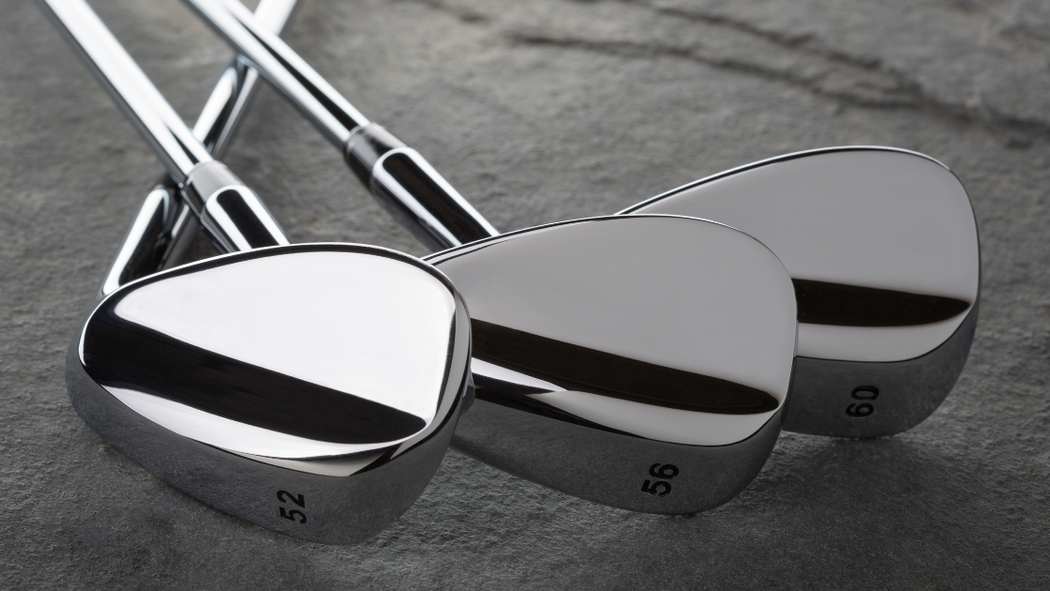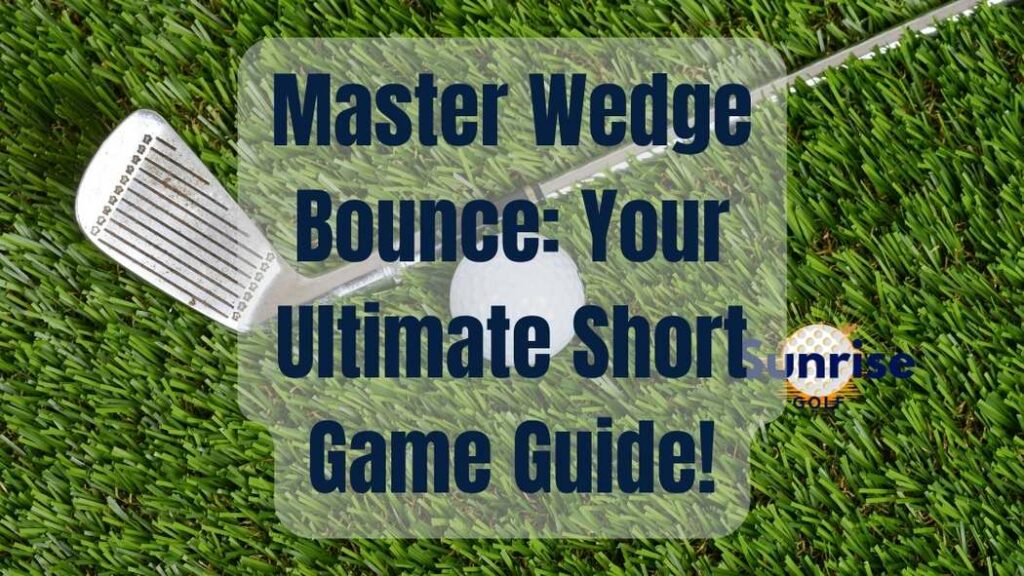Unlocking the secrets of your short game can be the key to lowering your golf scores and elevating your overall performance on the course. One often overlooked aspect that plays a significant role in fine-tuning your short game is understanding and mastering wedge bounce.
Imagine having the ability to adapt your wedge play to various course conditions and swing styles, giving you the confidence and control you need around the greens.
In this blog post, we will explore everything you need to know about wedge bounce, from the basics to its impact on ball spin and trajectory, and how combining bounce and grind can lead to maximum effect in your short game.
Understanding Wedge Bounce: The Basics
Wedge Bounce is the angle between the leading edge and the lowest point of the sole or trailing edge of a club that interacts with the ball.
This seemingly small detail has a considerable effect on shot trajectory, spin rate, and overall performance in your short game.
Understanding wedge bounce is essential for refining your technique and game, which in turn can help you choose the most appropriate wedges for your style of play.
The degree typically ranges between 4° and 14°, offering a wide variety of options to suit different swing styles and course conditions.
Bob Vokey, a renowned name in the world of golf wedges, has emphasized the importance of understanding wedge bounce and has designed a multitude of wedge combinations to cater to various golfers’ needs.
The main objective is to ensure that the wedge interacts optimally with the turf and makes proper contact with the ball, leading to improved results.
The ideal combination of wedge loft and bounce can significantly influence the way shots are struck, ultimately affecting your performance around the green.
Leading Edge and Sole
The relationship between the leading edge and the sole of the club determines the bounce angle.
There are three types of wedge bounce:
- Low-bounce wedges typically have 4-6 degrees of bounce
- Mid bounce wedges usually have 7-10 degrees of bounce
- High bounce wedges generally have 11-14 degrees of bounce
The bounce angle plays a crucial role in how the club interacts with the ground and consequently affects the ball spin and shot performance.
When selecting a wedge bounce, it is essential to consider factors such as swing style and attack angle, course conditions and turf type, as well as the loft and purpose of the wedge.
By understanding the bounce angle and how it affects your interaction with the turf, you can make informed decisions about which wedge bounces are most suitable for your specific situation and playing conditions.
Impact on Ball Spin and Trajectory
The degree of wedge bounce can influence the club’s interaction with the ground and, consequently, the ball spin. Wedges with a higher bounce can help prevent fat shots or digging into the turf by elevating the leading edge.
However, opening up the club face with a high-bounce wedge can be more challenging due to the increased height of the leading edge. High bounce wedges are especially beneficial when playing on softer turf and in deep soft sand bunkers. They also make it easier to hit with fluffy lies.
A high bounce wedge is ideal for soft turf, soft sand, and any type of bunker shot. It is best suited for golfers who desire to feel less club dig into the ground, as well as those who hit too high up on the club face and produce an ‘unwanted pop up, no spin shot’ when chipping and pitching.
This wedge grants golfers more control over their short game and the capacity to execute delicate shots with accuracy and precision.
The Three Types of Wedge Bounce

An overview of the three types of wedge bounce – low, mid, and high – reveals that each is designed for specific swing styles and course conditions. Low bounce wedges maintain the leading edge of the golf club elevated and above the turf at setup, while high bounce wedges keep the leading edge slightly more pointed downwards.
High bounce wedges are more forgiving if the ground is struck before the ball and the leading edge is dug in, while low bounce wedges offer more leeway for thin shots from tight lies.
By classifying wedges into distinct bounce angles, golfers can select the wedge that is most suitable for their swing style and the playing conditions they will face.
The Cleveland ZipCore wedge, for example, offers low, mid, and high bounce wedges to accommodate a range of golfer preferences and course conditions.
Experimenting with different bounces and understanding their effects on your wedge shots can help you find the perfect wedge combination for your game, especially when you learn how to effectively bounce on a wedge.
Low Bounce Wedges
Low bounce wedges are recommended for firm turf and require precise ball contact, making them most suitable for golfers with a shallow swing.
One such low bounce wedge provides the highest degree of control and is optimal for accurate shots from the vicinity of the green.
The low bounce angle allows the club to cut through firm turf with ease, making it perfect for golfers who prefer clean ball contact and minimal interaction with the ground.
However, low bounce wedges are not ideal for all situations and may struggle in softer turf or fluffy lies where a higher bounce wedge would excel. Understanding your swing style, course conditions, and the specific advantages of low bounce wedges can help you determine when and how to use them effectively in your game.
Mid Bounce Wedges
When it’s time to choose mid bounce wedges, keep in mind that they feature bounce angles between 7° and 10°, offering versatility for various turf conditions and are suitable for golfers with a neutral swing style and a moderate attack angle.
These wedges provide a great combination of control and forgiveness, making them suitable for golfers of any proficiency. The mid bounce angle allows the club to adapt to a variety of lies, ensuring optimal performance in different playing scenarios.
Whether playing on firm, normal, or even soft turf conditions, mid bounce wedges can provide the necessary adaptability to help you achieve the exact distance and trajectory control you need for constructing shots around the green.
By understanding the benefits and limitations of mid bounce wedges, you can confidently utilize them to improve your short game performance.
High Bounce Wedges
High bounce wedges, also known as high bounce sand wedges, are characterized by a bounce angle of greater than 10°, making them ideal for soft turf and helping to prevent the leading edge from sinking too deeply into the sand.
These wedges are designed for golfers with a steep swing angle and for playing in challenging conditions such as thick rough and soft sand.
The higher bounce angle elevates the leading edge of the club, reducing the likelihood of fat shots or digging into the turf.
Golfers who frequently play on courses with soft turf conditions or encounter fluffy lies may find high bounce wedges an invaluable addition to their bag. By understanding when and how to use high bounce wedges effectively, you can enhance your short game and gain an edge over your competition.
Factors to Consider When Choosing Your Wedge Bounce
Selecting the appropriate wedge bounce is crucial for maximizing your short game performance.
To do so, it is important to consider factors such as swing style and attack angle, course conditions and turf type, as well as the loft and purpose of the wedge.
By taking these factors into account, you can make an informed decision and choose the right wedge bounce for your specific needs.
The ideal bounce angle for a golfer is dependent on their swing style and the playing conditions, including the type of grass and turf firmness. By understanding your own swing style and the conditions you most frequently encounter on the course, you can select the optimal wedge bounce to enhance your game and achieve better results.
Swing Style and Attack Angle
Your swing style and attack angle are crucial factors in determining the ideal wedge bounce for your game. Golfers with a sweeper swing style, with a shallower attack angle, may benefit from low bounce wedges, while those with a steeper attack angle may benefit from higher bounce wedges.
By accurately assessing your swing style and attack angle, you can select the right wedge bounce that complements your natural tendencies, leading to improved shot consistency and performance.
For example, high bounce lob wedges may be particularly advantageous for golfers who have a deep swing and a steep attack angle. It is essential to match the angle to your swing style for optimal performance, as using the wrong bounce can lead to inconsistent shots and hinder your overall short game.
Course Conditions and Turf Type
Course conditions and turf type can have a significant impact on wedge performance and should be considered when selecting the appropriate bounce for your game.
Low bounce wedges are optimal for firm and tight lies, facilitating ease of cutting through turf. Mid bounce wedges are suitable for a variety of lies, whereas high bounce wedges are ideal for soft and fluffy lies, preventing excessive digging into the ground.
It is essential to consider the turf type and course conditions you most frequently encounter when selecting your wedge bounce.
By doing so, you can ensure that your wedges are tailored to your specific needs, allowing for optimal performance in various playing scenarios.
Loft and Purpose of the Wedge
The loft and purpose of the wedge play a significant role in determining the appropriate bounce for your game. The loft of a wedge is the angle of the clubface relative to the ground, and its purpose is to enable golfers to hit shots with greater control and accuracy from a variety of lies.
By understanding the loft and intended use of the wedge in your bag, you can make informed decisions about the right bounce options to choose.
For instance, a 56-degree sand wedge may benefit from 10-12 degrees of bounce, providing an ideal and reliable option for a variety of scenarios. By considering the loft and purpose of your wedges, you can tailor your wedge selection to best suit your game and improve your performance on the course.
Bounce and Grind: Understanding the Difference
Many golfers often confuse bounce and grind when discussing their wedges, but there is a clear distinction between the two terms. Bounce refers to the angle between the sole of the club and the leading edge, while grind is the manipulation or removal of material from the sole of a club.
Understanding the difference between bounce and grind is essential for fully grasping how these factors work together to enhance wedge performance and impact your short game.
Both bounce and grind play crucial roles in optimizing your wedge performance, with bounce affecting the trajectory and spin of the shot, and grind modifying the bounce and other characteristics of the wedge to accommodate different playing conditions and player preferences.
The Role of Grind in Wedge Performance
Grind is integral in forming the sole of the wedge, thus influencing its interaction with the turf, in tandem with the bounce angle. The shape of the sole, as determined by the grind, can affect how the club slides through the turf and contacts the ball, providing golfers with the ability to fine-tune their wedges to suit specific playing conditions and preferences.
By considering the grind options available for your wedges, you can further customize your club selection to optimize your performance on the course.
Whether you prefer a wide sole for maximum forgiveness or a narrow sole for increased precision, selecting the right grind to complement your bounce angle can make a significant difference in your short game.
Combining Bounce and Grind for Maximum Effect
To achieve maximum shot versatility and adaptability, it is essential to combine the right bounce and grind options for your wedges.
By understanding the specific advantages and limitations of each bounce and grind combination, you can tailor your club selection to your swing style, course conditions, and personal preferences, ultimately leading to improved performance.
To select the ideal combination of bounce and grind for your game, consider factors such as your swing style and attack angle, the course conditions and turf type, as well as the loft and purpose of the wedge.
By testing out various bounce and grind configurations and observing their effects on your shots, you can find the perfect wedge setup to enhance your short game and achieve better results on the course.
Tips for Improving Your Short Game with Wedge Bounce
With a solid understanding of wedge bounce and its impact on your short game, you can now take practical steps to improve your performance by utilizing it effectively.
By analyzing your strike pattern, experimenting with different bounces, and selecting the ideal combination of bounce and grind for your game, you can unlock the true potential of your wedge play and elevate your overall performance on the course.
Incorporating this knowledge into your practice routine and course strategy can lead to more consistent results, increased confidence, and a more enjoyable golf experience.
By continually refining your understanding of wedge bounce and applying it to your game, you can transform your short game and reach new heights in your golf performance.
Analyzing Your Strike Pattern
Assessing your strike pattern can help you determine the ideal wedge bounce for your swing. By examining the type of dives you take, your most frequent misses, and your overall swing characteristics, you can gain valuable insights into your natural tendencies and preferences.
This information can be used to select the right wedge bounce that complements your swing style and maximizes your performance around the greens.
Understanding your strike pattern can also help you identify areas for improvement and make adjustments to your swing as needed. By consistently analyzing your strike pattern and making necessary modifications, you can refine your short game and achieve better results on the course.
Experimenting with Different Bounces
One of the best ways to find the perfect wedge bounce for your game is to experiment with different bounce options.
By testing out a variety of wedges with low, medium, and high bounce angles, you can observe how each bounce impacts your shots, including the trajectory, spin, and turf interaction.
This hands-on approach can help you determine which bounce options are most suitable for your swing style, course conditions, and overall preferences.
Remember that finding the right bounce for your wedges takes time and practice.
Don’t be afraid to experiment and adjust your wedge selection as your game evolves and your needs change. By continually refining your understanding of wedge bounce and applying it to your game, you can unlock the true potential of your wedge play and elevate your overall performance on the course.
Final Thoughts
In conclusion, understanding wedge bounce and its impact on your short game is a crucial component of elevating your golf performance.
By grasping the fundamentals, familiarizing yourself with the different types of wedge bounce, and considering key factors such as swing style, course conditions, and wedge purpose, you can make informed decisions about the ideal bounce angle for your game.
Furthermore, by understanding the difference between bounce and grind and how they work together to enhance wedge performance, you can optimize your club selection for maximum shot versatility and adaptability.
By analyzing your strike pattern, experimenting with different bounces, and selecting the right combination of bounce and grind for your game, you can unlock the true potential of your wedge play and reach new heights in your golf performance.
Ultimately, the path to mastering wedge bounce and transforming your short game requires consistent practice, experimentation, and a commitment to continuous improvement.
By incorporating this knowledge into your golf game, you can achieve more consistent results, increased confidence, and a more enjoyable golf experience.ting in deep dives, opt for higher bounce wedges.

